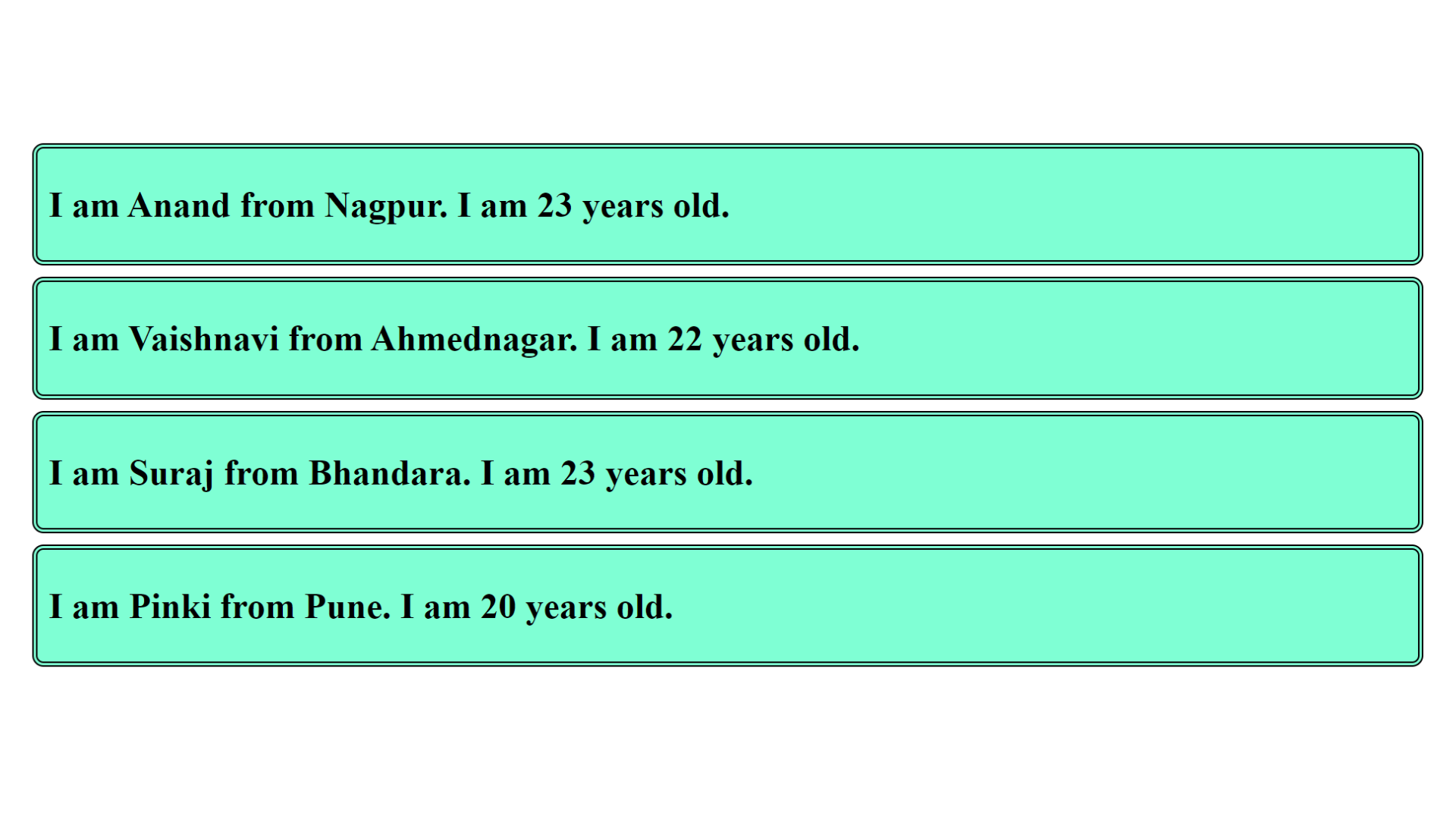Styling React Components
Exploring CSS Styling Methods in React :
- Inline CSS
- Document CSS
- External CSS
import ReactDOM from "react-dom/client";
const root = ReactDOM.createRoot(document.getElementById("root"));
function Greeting(props) {
const { name, city, age } = props;
return (
<div
style={{
border: "5px double black",
backgroundColor: "lightblue",
borderRadius: "10px",
padding: "10px",
margin: "10px",
}}
>
<h1 style={{ color: "tomato" }}>
I am {name} from {city}. I am {age} years old.
</h1>
</div>
);
}
root.render(
<>
<Greeting name="Anand" city="Nagpur" age="23" />
<Greeting name="Vaishnavi" city="Ahmednagar" age="22" />
<Greeting name="Suraj" city="Bhandara" age="23" />
<Greeting name="Pinki" city="Pune" age="20" />
</>
);
Output :
- Document CSS : Document CSS, also known as embedded CSS, involves placing CSS styles within a
<style> tagwithin theHTML document or JSX file. These styles apply to the entire document or a specific section, making them reusable within that document.
import ReactDOM from "react-dom/client";
const root = ReactDOM.createRoot(document.getElementById("root"));
const cardStyle = {
border: "4px double black",
backgroundColor: "aqua",
borderRadius: "10px",
padding: "10px",
margin: "10px",
};
const headingStyle = {
color: "tomato",
};
function Greeting(props) {
const { name, city, age } = props;
return (
<div style={cardStyle}>
<h1 style={headingStyle}>
I am {name} from {city}. I am {age} years old.
</h1>
</div>
);
}
root.render(
<>
<Greeting name="Anand" city="Nagpur" age="23" />
<Greeting name="Vaishnavi" city="Ahmednagar" age="22" />
<Greeting name="Suraj" city="Bhandara" age="23" />
<Greeting name="Pinki" city="Pune" age="20" />
</>
);
Note : in HTML we use class to take class but in react we have to use ClassName for that otherwise it will give warning.
- Inline CSS : In React,
inline CSSrefers to adding CSS styles directly to individualJSX elements using the style attribute. It allows for unique and immediate styling of specific elements within a component.
Output :
- External CSS : External CSS refers to placing CSS styles in a separate
external file (typically with a .css extension)and linking it to your React components. This method promotes reusability and separation of concerns, as the styles can be shared across multiple components or pages.
import ReactDOM from "react-dom/client";
import "./index.css";
const root = ReactDOM.createRoot(document.getElementById("root"));
function Greeting(props) {
const { name, city, age } = props;
return (
<div className="card">
<h1>
I am {name} from {city}. I am {age} years old.
</h1>
</div>
);
}
root.render(
<>
<Greeting name="Anand" city="Nagpur" age="23" />
<Greeting name="Vaishnavi" city="Ahmednagar" age="22" />
<Greeting name="Suraj" city="Bhandara" age="23" />
<Greeting name="Pinki" city="Pune" age="20" />
</>
);
File Name : index.css
.card {
border: 5px double black;
border-radius: 10px;
padding: 10px;
margin: 10px;
background-color: aquamarine;
}
Output :
Conditional Rendering
Example :for conditions
import ReactDOM from 'react-dom/client';
import './index.css';
const root =ReactDOM.createRoot(document.getElementById("root"))
function StudentCard({name,city,gender}){
return(
<div className={student-card ${gender == "female" ? "bg-female" : "bg-male"}}>
<h3 className='card-heading'>Hi I am {name} {gender}</h3>
<p className='card-subheading'>I am from {city}</p>
</div>
)
}
root.render(
<div className='student-card-container'>
<StudentCard name="Sakshi" city="Ahmednagar" gender="female"/>
<StudentCard name="Sneha" city="Pune" gender="female"/>
<StudentCard name="Neha" city="Ahmednagar" gender="female"/>
<StudentCard name="Ashish" city="Ahmednagar" gender="male"/>
<StudentCard name="Harshal" city="Pune" gender="male"/>
<StudentCard name="Omkar" city="Ahmednagar" gender="male"/>
</div>
)
File Name : index.css
.student-card-container {
display: flex;
}
.student-card {
padding-left: 20px;
border-radius: 5px;
margin: 10px;
height: 200px;
width: 200px;
}
.bg-female {
background-color: rgb(231, 7, 26);
}
.bg-male {
background-color: aquamarine;
}
Output :

Explanation :
This code demonstrates how to create and render a React component (StudentCard) multiple times with different props, and how to conditionally apply CSS classes based on prop values.
In line 1 and 2 ,code imports the ReactDOM module from 'react-dom/client' and an external CSS file './index.css'.
In Line 3 ,it creates a root React element using ReactDOM.createRoot(). It specifies that the root element in the HTML document with the id "root" will be the container for rendering React elements.
In line 5 to 11 , it defines a functional React component StudentCard. It takes three props: name, city, and gender. Inside the component, it returns JSX, which represents the structure and content of the component. The class name of the <div> element is conditionally set based on the gender prop.
In line 12 to 21 , it renders the root React element created earlier. Inside the root element, it renders a
with the class name 'student-card-container', containing multiple StudentCard components with different props (name, city, gender).

